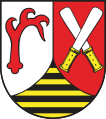Sideboard knife


A Kredenzmesser or serving knife was used for serving food and had therefore a trowel-like widened blade.
history
The knife itself has a long history of development. From the use of a knife at the table for the so-called “Trinicierens” ceremony, that is, slicing and presenting meat in particular to the guest, a real cult developed at noble dining tables. The function of carving was later taken over by the carving knife and the serving knife only served as a serving set . It was only used to serve food and therefore had a trowel-like widened blade. It no longer had a sharp cutting blade. It spread from Italy in the 2nd half of the 14th century. The design of the knife was always very decorative on the handle.
Sideboard knife in coat of arms
Two sideboard knives , or serving knives , are crossed in the coat of arms of Ditfurt and the Harz district , which emerged from the Quedlinburg district , among others. In the back of the coat of arms of the former district of Quedlinburg are two diagonally crossed silver sideboard knives with golden handles. Even Bad Suderode shows the crossed knives.
The knives had their origin in the coat of arms of the bishopric of Quedlinburg. Around 1541, the place Ditfurt was granted the right to use it in the coat of arms by the abbot of the Reichsstift. The pen had used a seal with that nasty figure .
In the town hall of Quedlinburg , the city coat of arms and underneath the crossed sideboard knives of the women's monastery can be seen on a glass window in the staircase.
Ditfurt coat of arms with crossed sideboard knives Coat of arms of the Harz district with crossed vanity knives Coat of arms of the former Quedlinburg district with crossed sideboard knives Bad Suderode coat of arms with crossed sideboard knives



